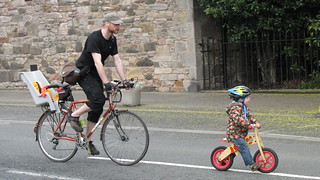Recently there's been some discussion in Spokes as to whether we should be pushing for protected two-stage right turns when segregated cycle routes pass junctions. It would be good to get some wider feedback from CCE.
David Hembrow is very strongly against them, you can see a blog of his here, there's a video on that blog showing a very poor implementation of a two stage right turn, but it at least gives you an idea if you haven't seen them before. The London Cycling Campaign has welcomed two stage turns, although criticised when they have been done poorly.
David Hembrow advocates the use of simultaneous green for bikes and pedestrians, when all branches of the junction have green. As far as I understand, this allows cycles to go across pedestrian lights when pedestrians have a green man, as in Holland. Leaving aside any discussion of whether this is okay, it would be hugely controversial, need legislation, and just isn't an option for things being designed such as Leith Walk / E-W route.
Effectively we are discussing whether there should be both an ASL and a safer but slower two stage turn for people turning right, or just the ASL.
The presence of a two-stage right turn doesn't stop anyone using the one-stage ASL option, but is seen by many as creating a 'dual network', where cyclists who want safety are forced to wait longer. On the other hand, if lots of people just get off and push because they find it too scary to use the right turning ASL then this dual network already exists.
So anyway, I think I'm inclined towards saying that if a two-stage crossing can be put in that doesn't stop anyone using the ASL and doesn't take any pavement space then it's a good thing. Any other thoughts?

 posts
posts
